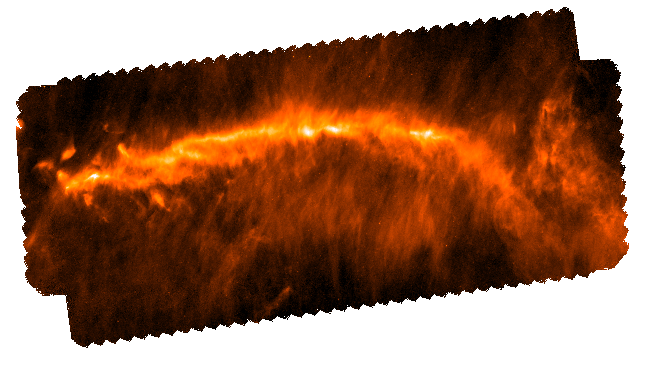 Earth & Space
Earth & Space
The Magnetic “Song” Of The Molecular Cloud Musca
The structure of molecular clouds holds the key to understanding the initial conditions of star and planet formation. However, their disordered appearance and projection effects hinder all efforts to model them. An exception to this messy picture is molecular cloud striations: ordered, quasi-periodic structures formed by hydromagnetic waves.

Stars, the building blocks of galaxies, and planets, the hosts of life, are born inside vast clouds of gas and dust found in the interstellar medium. Understanding the processes that control the evolution of these clouds is a significant task if we wish to understand star and planet formation, and how life on our own planet came to be. So far, we know that the self-gravity is responsible for pulling high-density clouds together and turning them into stars, and we know that this process of turning gas into stars is extremely inefficient.
In order to explain this inefficiency two processes are invoked: magnetic fields and turbulence. Clouds, indeed appear to be turbulent. Chaotic motions can disperse high-density concentrations of gas preventing gravity from taking over. On the other hand, clouds are also observed to be magnetized. In the magnetically regulated picture of star formation, it is the "battle" between gravity and the magnetic fields which oppose the contraction of the high-density concentrations that determine if and what type of stars will be born. One of the reasons why, after decades of research, we are not able to distinguish which process, other than gravity, regulates stars formation is because we can only see the two-dimensional projections of clouds on the plane of the sky, thus missing out essential clues imprinted in their 3-dimensional shapes. For example, in the turbulence-dominated picture, clouds are expected to have cylindrical/filamentary shapes whereas in the magnetically regulated scenario clouds would be more flattened, like a disk or a pancake.
Striations are structures recently discovered on the outskirts of clouds. Striations are well-ordered, have a hair-like morphology and wherever they are observed they always appear to be parallel to the magnetic field. Because they are parallel to the magnetic field, a possible explanation behind their formation is that of magnetic waves. Magnetic field lines oscillate dragging gas with them, creating compressions and rarefactions which we then observe. In the presence of boundaries, waves can get trapped. However, trapped waves are like a fingerprint. Their frequencies are unique and by analyzing them we can deduce the sizes of the boundaries that trapped them. Just like a trumpet and a tuba produce very distinct sounds, striations in clouds with different shapes and sizes will have very distinct frequencies; they will "sing" different "songs".
In the case of Musca, an isolated cloud observed from the Southern hemisphere, they surround a dense filamentary structure. Because of its elongated morphology, as this is projected on the plane of the sky, Musca was considered the best example of a cylindrical cloud found in nature. However, there was more than meets the eye. By measuring the spacing between striations we were able to determine the frequencies of the magnetic waves causing them. Using just the first two frequencies measured in the observations and our theories for trapped waves we calculated some values for the length and depth of the cloud. We used these values and predicted all of the higher frequencies. All of the predicted frequencies were in excellent agreement with the rest of the frequencies measured in the observations. We were thus certain that these are indeed trapped waves and that our measurements of the length and depth of the cloud were correct. What we found was that, despite its filamentary appearance, the depth of Musca is, in fact, comparable to its length. As a result, the true structure of the cloud is that of a sheet, we just happen to see it edge-on.
Musca's flattened shape is evidence that, at least in this cloud, the evolution is controlled by the magnetic field. Application of this method to more clouds and measurements of their 3-dimensional shapes are necessary in order to reach definitive conclusions about the processes that control star formation. However, even if Musca is proven to be the only cloud with trapped waves and the only one for which its 3-dimensional structure can be determined, it can serve as the prototype against which our models of star formation are put to the test.
Original Article:
A. Tritsis, K. Tassis, Magnetic seismology of interstellar gas clouds: Unveiling a hidden dimension. Science 360, 635-638 (2018)Next read: Animal magnetism: how magnetic fields can influence chemistry in living cells by Jonathan R. Woodward , Noboru Ikeya
Edited by:
Massimo Caine , Founder and Director
We thought you might like
More from Earth & Space
Discovery of the first radiation belt beyond the Solar System
Jan 27, 2025 in Earth & Space | 3.5 min read by Juan Bautista Climent OliverOne million (paper) satellites
Jan 24, 2025 in Earth & Space | 3 min read by Ewan Wright , Andrew FalleVolcanic Ash: A Nutrient Boost for Reef-Building Corals
Sep 18, 2024 in Earth & Space | 4 min read by Frank Förster , Tom SheldrakeAmmonia Energy: A Call for Environmental Awareness
Aug 29, 2024 in Earth & Space | 3.5 min read by Matteo Bertagni , Robert Socolow , Amilcare PorporatoLikely increase in coral thermal tolerance at a Pacific archipelago
Dec 29, 2023 in Earth & Space | 3 min read by Liam LachsEditor's picks
Trending now
Popular topics


